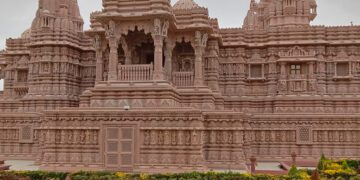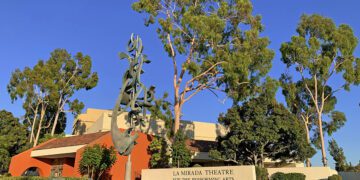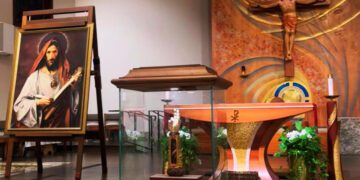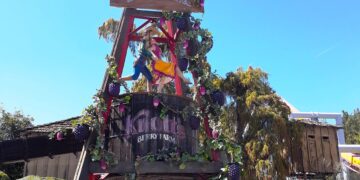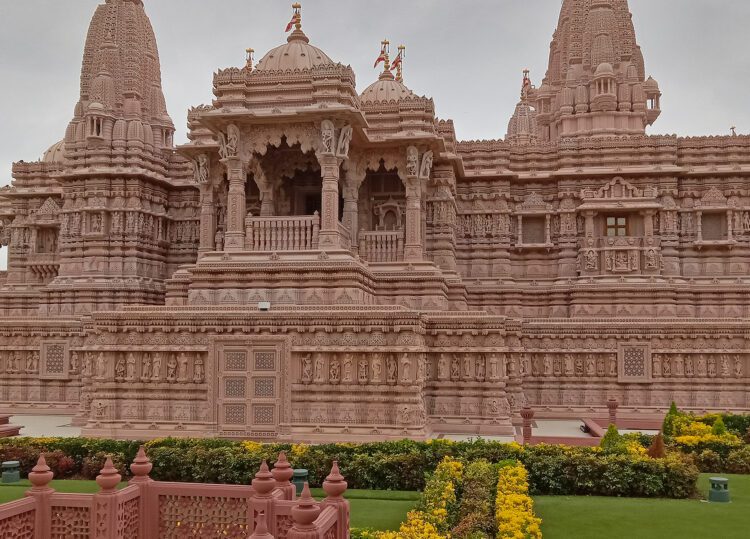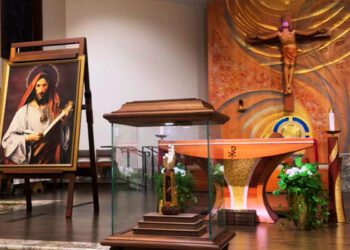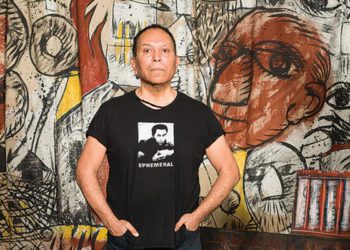A Mandir is a Hindu place of worship, a place of spirituality and paramount peace. It is also a center for vibrant social, cultural and spiritual activities.
All in a day’s drive, nestled quietly in Chino Hills is the BAPS Shri Swaminarayan Mandir Hindu temple complex. The temple belongs to the Bochasanwasi Akshar Purushottam Swaminarayan Sanstha denomination of Hinduism.
The BAPS Shri Swaminarayan Mandir was inaugurated on December 23, 2012 after years of tireless dedication utilizing over a million volunteer hours. The Mandir is comprised of two types of stone: Italian Carrara marble and Indian pink sandstone. Individual stone pieces were caver by hand, shipped to the U.S. and assembled in Chino Hill like a giant 3-D jigsaw puzzle. It is an absolute masterpiece of construction.
Inspired by His Holiness Pramukh Swami Maharaj, a handful of devotees began conducting weekly assemblies in the late 1970’s and early 1980’s. In 1984, His Holiness inaugurated the first BAPS Swaminarayan Mandir in Whittier. With the guidance and blessings of His Holiness, the congregation grew from just a handful of families to a strong group of dedicated devotees who yearned for spiritual growth. In 2000, His Holiness visited the current site of the BAPS Shri Swaminarayan Mandir in Chino Hills and invigorated the congregation’s desire to build a traditional Hindu Mandir. The congregation completed the Haveli building, commonly known as the Visitors Center in 2007. In 2012, the BAPS Shri Swaminarayan Mandir in Chino Hills was dedicated and opened with great joy. This Mandir is the fifth traditional Hindu Mandir in North America.
Constructing a traditional Hindu Mandir in the 21st century requires the perfect combination of state-of-the-art engineering methodology and ancient carving techniques. From cutting-edge earthquake protection technology to hand-carved marble archways, this Mandir represents a unique fusion of traditional Indian architecture and modern construction.
A special team of architects and engineers surveyed the Chino Hills area before selecting the type of stone to be utilized in constructing the Mandir. Recognizing the lush green hills and the mountainous peaks, the team chose pink sandstone from Rajasthan, India, for the exterior of the Mandir. The interior of the Mandir is comprised of white Italian marble from the quarries of Carrera, Italy. To ensure continuity inside the Mandir, each piece of marble was hand-selected, closely analyzed and chosen for extraction. From Italy, each block of marble was shipped to India where it was unloaded at a port, driven to specialized artisan centers and prepared for carving. Thereafter, skilled artisans and craftsmen intricately hand-carved marble slabs and pieces of stone for placement in the Mandir. Once complete, each stone was identified with a series of numbers and letters, packed into tailored containers, and shipped to the United States. The Indian pink sandstone underwent a similar process.
Shipments of the sandstone and marble arrived at the Port of Long Beach and were transported to Chino Hills, where they were assembled similar to a jigsaw puzzle-piece by piece.
Southern California is well-known for earthquakes. In fact, the San Bernardino area, including Chino Hills, is a hotbed for seismic activity. To protect the Mandir for thousands of years against natural disasters, BAPS combined ancient engineering practices with modern technology, utilizing cutting-edge seismic technology to protect the Mandir against earthquakes. The technology, known as base isolation systems, consists of steel plates stacked together with viscous liquid to allow for lateral movements in the event of an earthquake. The Mandir is supported by 40 base isolators, which allow the upper portion of the Mandir to remain separate from the foundation. Engineers and architects have deemed it the “floating” Mandir.
Additionally, the Mandir is powered by green energy. BAPS is committed to protecting the environment through conservation, sustainability, awareness and efficiency. The solar power system, induced through solar carports, generates electricity and reduces the carbon footprint of the Mandir. Over a 25 year period, the solar panels will reduce 1,556 tons of carbon dioxide gases, which is the equivalent of planting 62,244 trees.
The lower floor of the Mandir is home to an interactive exhibition on the history, culture and wisdom of Hinduism. Visitors can learn about the origin, beliefs, and values of Hinduism, and how this ancient religion is thriving today throughout the world.
The exhibition also features a documentary on the construction of the Mandir and the contribution of the volunteers and the residents of the City of Chino Hills.
This is a must-see. It is one of those structures that make you gasp at the size and beauty at first site, but as you walk closer to the structure you can’t help but be awestruck at the intricacy of each carving that incases the entire Mandir.
Located at 15100 Fairfield Ranch Rd, Chino Hills it will take about 45 minutes in good traffic.
For more information visit www.baps.org









